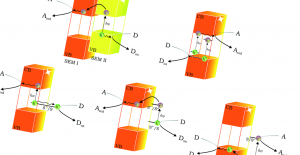Tomasz Baran has got his PhD degree. Congratulation!
Photocatalytic reduction of carbon dioxide in hybrid systems
Carbon dioxide utilization may contribute to controlling its atmosphere level, reducing the emission and recycling carbon. Various methods of CO2 reduction are under intensive study, including photocatalysis that is promising, environmentally friendly technique of solar to chemical energy conversion. Three strategies of CO2 reduction to useful chemicals and fuels were investigated: photocatalytic carboxylation of organic compounds with CO2 reducing coupling, photocatalytic CO2 reduction to C1 compounds and bioinspired systems for CO2 reduction to methanol by an enzymatic way with photocatalytic regeneration of coenzyme. Carboxylation of acetylacetone and 2,3-dihydrofuran with carbon dioxide has been performed by using ZnS-based photocatalysts. The formation of carboxylic acid, as proven by 13C NMR, GC-MS and IR, was observed. The reaction efficiency was enhanced after modification of ZnS with ruthenium nanoparticles. The reaction involves one-electron reduction of CO2 to CO2.-with photogenerated electrons from the conduction band of ZnS and one-hole oxidation of organic substrates to the relevant radical. Coupling of formed radicals leads to the formation of carboxylic acids through C-C bound formation. Multielectron CO2 reduction to C1 molecules has been studied using various neat and modified materials: ZnS, CuI, NiO, CuS. HCOOH and CO were found as the main reduction products. The amount and ratio of products were influenced by the type of materials, the presence of deposited ruthenium(0) nanoparticles at the surface of materials and solvent polarity. Last approach of CO2 utilization based on photochemical regeneration of NADH for the enzymatic CO2 to CH3OH reduction through the enzymes cascade: FateDH, FaldDH and ADH. A series of photocatalysts was employed as photocatalyst of reduction of NAD+ to NADH under visible light irradiation. TiO2 photosensitized with organic dye and inorganic chromium complexes, narrow band gap photocatalysts such as Cu2O and InVO4 as well as ZnS doped with iron or cobalt cations seems to be the most promising photocatalysts. Thorough investigations led to the development of a photocatalytic systems constructed of photocatalyst and electron mediator that yield in selective and efficient regeneration of 1,4-NADH isomer.studied processes can find applications for the solar-light-driven green synthesis of fuels or Cn+1 carboxylic compounds from Cn substrates by utilizing carbon dioxide.

